25 Oct 2021 | News, The climate crisis, Uganda, Volume 50.03 Autumn 2021, Volume 50.03 Autumn 2021 Extras
Uganda’s natural resources base, one of the richest and most diverse in Africa, continues to be degraded, jeopardising both individual livelihoods and the country’s economic development.
Evidence from the UN Environment Programme reveals that its forests, home to several endangered or soon-to-be extinct animal and plant species, are being mercilessly ravaged by poachers, illegal charcoal traders and loggers, and greedy investors.
Overfishing in the country’s lakes and rivers is rife. Its wetlands are being cleared for agricultural use and the rate of forest cover loss stands at 2.6 per cent annually, according to independent sources.
As part of efforts to ensure that the east African nation’s natural resources are effectively managed and protected, a group of environmental activists has gone to war to protect these natural wonders from bleeding further.
“Environmental activism in Uganda is not a safe identity – it’s a hostile and fragile environment,” William Amanzuru, team leader at Friends of Zoka, told Index.
“Activists are seen as fronting foreign views and opinions, enemies of the state and enemies of development.”
Amanzuru, who won the EU Human Rights Defenders Award in 2019, says environmental abuse in Uganda is highly militarised, so any intervention for nature conservation seems like a battlefield in a highly sophisticated war.
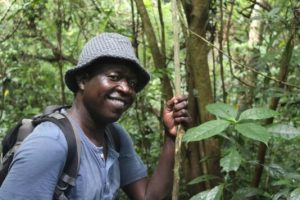
William Amanzuru, team leader at Friends of Zoka
“You directly deal with our finest military elite who run the show because of the huge profits gained from it,” he said. “We are always being followed by state and non-state actors and those involved in the depletion of natural resources like the Zoka Central Forest Reserve.”
Amanzuru said he had received threatening phone calls and had been intimidated by government and local police officials. “My phone is always tapped,” he added.
Anthony Masake, programme officer at Chapter Four Uganda, a human rights organisation, said environmental human rights defenders in Uganda were increasingly operating in a hostile environment.
“They repeatedly face reprisal attacks in the form of arbitrary arrests and detention, character assassination, being labelled traitors, assaults, intimidation and isolation, among others,” he said.
Masake added that illegal loggers and charcoal dealers, land grabbers and corporations often connived with their government backers to shield them from the law and accountability.
“Politicians, police officers and local leaders have often been cited in incidents of reprisal attacks against environmental defenders in Adjumani, Hoima and other districts,” he said.
Hidden from view
Uganda’s environmental battlefields are located in rural and remote areas where life and time seem to stop – far from the public eye and the noise and the vibe of big cities.
“The terrain has exposed them to easy targeting because the operation areas are far removed from urban areas where they would be able to access quick and competent legal services,” said Masake.
“The rise of incidents of corruption, abuse of office, lack of accountability for abusers and deterioration of the state and rule of law has further emboldened perpetrators to continue attacking environmental defenders because they know they can get away with it.”
As watchdogs of society, journalists who attempt to expose environmental crimes and abuse are also often the victims of sheer brutality and violence, according to several sources who spoke to Index.
“I deplore the way [president Yoweri] Museveni’s security forces ill-treat journalists, especially environmental journalists,” said one. “They have done nothing wrong. All they do is to tell the nation and the world that our natural resources are in danger of being extinct if we do not trade carefully. Is that a crime?”
The journalist, who claimed to fear Ugandan security forces and intelligence services “more than God”, spoke only on condition of anonymity.
Silencing the critics
The International Federation for Human Rights (FIDH) and its partners, the Observatory for the Protection of Human Rights Defenders and the World Organisation Against Torture, have vehemently and repeatedly condemned the arrest and arbitrary detention of environmental journalists.
Venex Watebawa and Joshua Mutale, the team leader and head of programmes at Water and Environment Media Network (Wemnet), were recently arrested in Hoima, in western Uganda, on their way to attend a radio talkshow at Spice FM.
The FIDH reported that they were supposed to discuss the risks and dangers of sugarcane growing projects in the Bugoma forest and of allowing oil activities in critical biodiversity areas including rivers, lakes, national parks, forests and wetlands.
Home to more than 600 chimpanzees and endangered bird species, including African grey parrots, Bugoma is a tropical rainforest which was declared as a nature reserve in 1932.
Following the arrest of Wemnet members, all hell broke loose when security forces arrested more environmental activists who went to the police station to negotiate the release of Watebawa and Mutale.
The arrests, which are believed to have been called for by Hoima Sugar, the company decimating the Bugoma forest to convert it into a sugarcane plantation, were a bitter pill to swallow. (Index asked Hoima Sugar to comment on these allegations but received no response.)
“Environment stories are so delicate because the people behind the destruction of the environment are people with a lot of money, who are well connected and have a lot of influence,” Watebawa told Index.
He slammed the National Environment Management Authority – which is mandated to oversee conservation efforts – for having been influenced by Hoima Sugar.
“To our surprise, it gave a report in a record time of two weeks to clear the below-bare-minimum-standard environmental impact assessment report to clear 22 square miles of land in a sensitive and fragile ecosystem,” he said.
“The deployment of paramilitary agencies to give sanctuary to the destroyers of the forest speaks volumes of the government’s commitment to protect the environment.”
Journalists who have attempted to get anywhere near the Bugoma central forests have been harassed or faced the wrath of the army.
“These incidents have demotivated and scared us,” said Watebawa. “Between March and June, two of our members lost their cameras and laptops. Our communications officer, Samuel Kayiwa, was trailed, his car broken into in Kajjasi, and his gear stolen.”
The trade in environmental abuse
In another incident targeting the environmental media, Wemnet reported that someone broke into the house of Agnes Nantambi, a journalist working for New Vision, after midnight, forcing her to surrender her laptop and camera.
Amanzuru was arrested in February after an incident in which locals impounded a Kampala-bound truck ferrying illegal charcoal. He claimed that the military provided protection for those investing in illegal logging, illegal timber harvesting and the commercial charcoal trade.
He said the country’s environment sector was highly politicised, with the government drawing a lot of illicit money from the abuse of natural resources.
“Politicians trade in environmental abuse because this is an unmonitored trade … They make quick money for their political sustainability.”
And as the Museveni government’s aggression towards environmental activists increases day by day, human rights organisations have vowed to fight and to die with their boots on.
Amanzuru’s arrest attracted the attention of the EU ambassador to Uganda, who wrote to environment minister Beatrice Anywar Atim to request a fair and speedy trial.
Entities offering support include the Defenders’ Protection Initiative, Chapter Four Uganda and the National Coalition of Human Rights Defenders in Uganda.
But despite the grim outlook, Watebawa remains optimistic about the future of environmental activism.
He says society is stronger, more organised and more determined than ever, and the media persistently exposes environmental abuse.
He believes all responsible citizens must challenge the impunity to which environmental human rights defenders so often fall victim because the environment, ultimately, is a shared resource.
19 Oct 2021 | Ecuador, The climate crisis, Volume 50.03 Autumn 2021, Volume 50.03 Autumn 2021 Extras
[vc_row][vc_column][vc_single_image image=”117715″ img_size=”full” add_caption=”yes” alignment=”center”][vc_column_text]Ecuador is not a safe country for environmental defenders. They are criminalised, threatened, attacked and even assassinated for attempting to uphold the rights of nature decreed in the constitution.
While the overt incitement to hatred against environmental activists ended when Lenin Moreno replaced Rafael Correa as president in 2017, and some imprisoned indigenous leaders were freed, the intimidation and threats continue.
In 2018, there were several attacks against members of the Collective of Amazonian Women who work to defend the Amazon region from oil and mining. Margoth Escobar had her house set on fire and Patricia Gualinga, from Sarayaku, had rocks thrown through her bedroom windows at night. Others received death threats.
The same year, three water defenders – including Yaku Pérez Guartambel, then president of indigenous peoples’ organisation Ecuarunari – were kidnapped by mine workers, believed to have been following orders from above. An angry mob kicked, dragged and tortured Pérez Guartambel, accusing him of leading anti-mining efforts. They planned on crucifying him and started gathering materials until a group of journalists broke through with cameras and rescued him.
Since a 2019 uprising of indigenous peoples in the country, the government has more forcefully set its sights on the indigenous movement as the internal enemy to be defeated.
Indigenous leaders are repeatedly persecuted and intimidated. The repressive apparatus has been strengthened, with millions of dollars allocated for the provision of equipment for the police and military. The creation of a new legal framework in May 2020 would have enabled the deployment of the military to control internal order. This would have provided protection to strategic sectors such as mining, against which indigenous communities have been struggling for years.
In May 2021, right-wing banker Guillermo Lasso assumed the presidency in Ecuador, ending more than a decade of left-wing rule. Index on Censorship spoke to Franco-Brazilian academic and indigenous rights activist Manuela Picq about what the change means for censorship. After marrying Yaku Pérez Guartambel in an indigenous ceremony, Picq was herself censored by the government of Rafael Correa, which forced her into a three-year exile.
“There are many ways of censoring. We have seen traditional censorship mostly from the left in Ecuador, by Correa in particular, who implemented very repressive media legislation and enforced it with violent oppression. Then there are other forms of censorship, which are not traditionally recognised as such, the neo-liberal way of buying support. Under Lasso, journalists and media outlets are not fulfilling their critical role because they receive so much state advertising revenue. I see this as a form of censorship, when the public is left uninformed about the government’s activities, which happen largely in the dark. In this context, whistle blowers will play a critical role,” said Picq.
“This is a weak government that has been forced to ally with Pachakutik, the political party of Ecuador’s indigenous movement, which is currently presiding over congress. This means Lasso will carry out his agenda in the most discreet way possible, to avoid being overthrown. So, mining in indigenous territories, or the privatisation of the public sector will be labelled as “development”. We are relieved in Ecuador that we no longer have Correa-ism, with its traditional, explicit forms of censorship, but we should not underestimate the other forms of censorship that are more subtle and insidious.”
The multicoloured people
Jimmy Piaguaje is a young indigenous Siekopai defender from Siekoya Remolino, a community of 53 families living on the banks of the Aguarico River in the north-eastern Ecuadorian Amazon region.
The Siekopai (which means multicoloured people) are renowned for their shamanic acumen and knowledge of medicinal plants, with uses for more than 1,000 different plants.
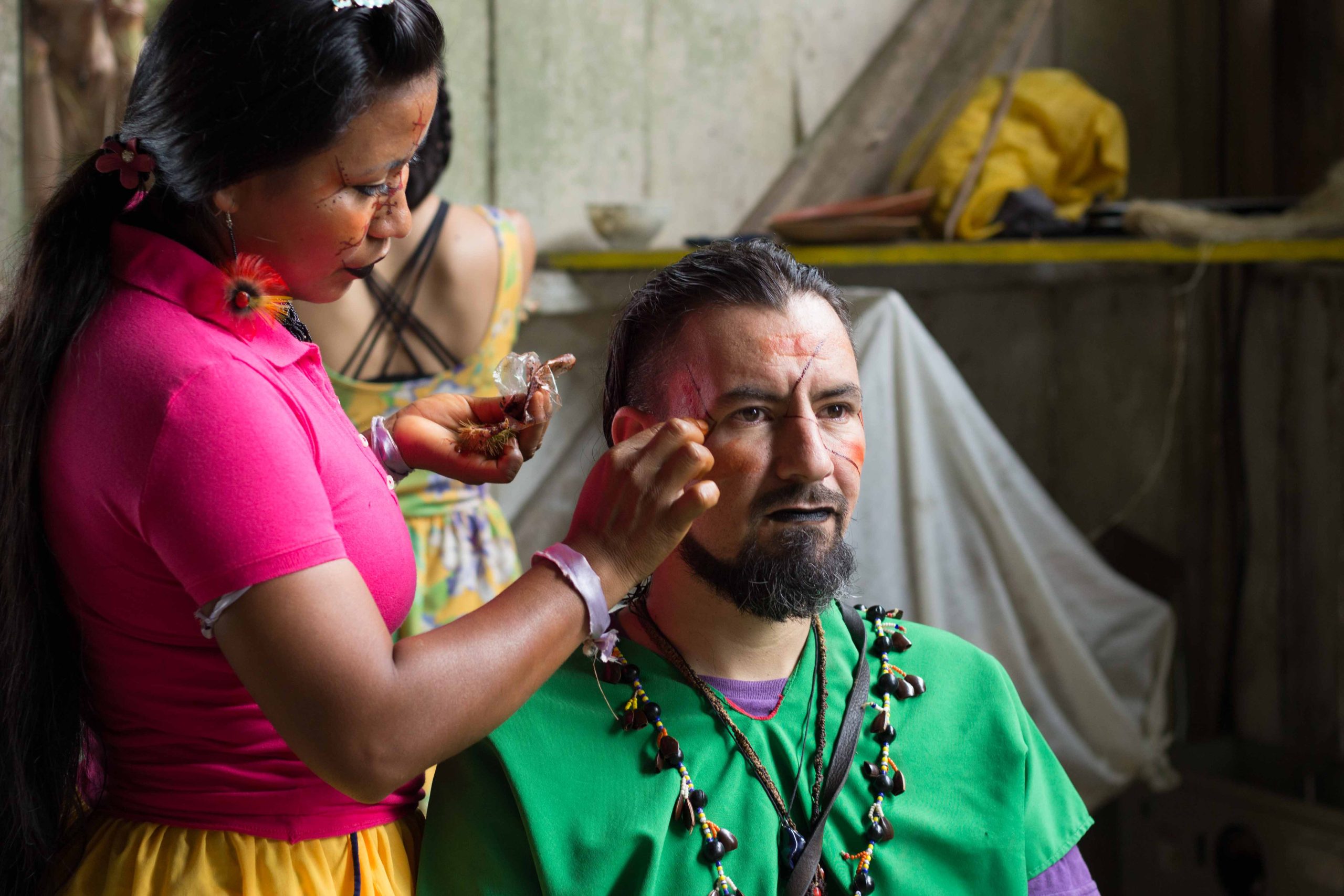
The Siekopai are known as the multicoloured people, photo: Erin Deo
In the 1600s, when Jesuit missionaries arrived in Siekopai territory, there were 30,000 to 40,000 Siekopai in the zone between Putumayo, the Aguarico River and Napo.
Traditionally, the Siekopai lived communally in gigantic malokas (open sided wooden huts) with 40 to 60 families. This coexistence meant that people did everything together. Everyone got up at about 3am to prepare and drink yoko, twist threads of chambira (a palm from which the fibre is removed to make hammocks) and tell stories. The women would discuss what they would do that day, what the future would bring. The children would be there, too, learning from their parents and elders.
The missionaries brought illnesses such as measles, wiping out 90% of the population. Whole peoples and clans disappeared. The few who survived did so by hiding in the depths of the jungle. Then the rubber-tappers arrived and removed the Siekopai from there, too.
Currently only around 1,600 Siekopai remain – 900 in Peru and 700 in Ecuador, where they live in a 50,000-acre fragment of rainforest.
“We feel very threatened, very worried, because our territory is very small and we are surrounded by oil exploitation and monoculture agriculture,” said Piaguaje.
“I know from talking with my father, with our elders, how our territory used to be. Now we have almost no resources, almost no fish, no animals to hunt. Our rivers are contaminated by toxic waste from the oil palm industry. Lack of food sovereignty is a really big worry. These are the threats that we are facing.
“All of these things have made us think about where we are going. Will our culture survive another five, 10, 20 years? Or will we just die?”
The pandemic, too, has had a deep impact on the Siekopai.
“In the Ecuadorian Amazon, the Siekopai nationality was the first to confirm positive cases of Covid-19,” said Piaguaje. “A wise elder who died of Covid – a family member of mine – knew a lot about medicinal plants. That was major blow for the Siekopai because there aren’t many of us and we all know each other. Then a teacher died; he had long been involved in the struggle to defend our culture. It was a very difficult situation.”
The Siekopai sought help from the local and national governments but there was little or no response, although some organisations provided medicine, tests and accurate information.
“We started to realise that the medicine from outside wasn’t helping us,” said Piaguaje. “Faced with many cases of Covid, we started to look to medicinal plants. In the end, the majority of people who survived were treated with medicinal plants. And we’re still treating people with plant infusions, such as ajo del monte, chinchona and cedros, with good results.
“This has led to some very important reflections within the Siekopai communities; a rediscovery, appreciation and faith in our own ancestral medicines. And when everything collapsed in the outside world, although we were affected, we were more or less OK. This has been a deep reflection for us, seeing how the rest of the world is suffering and realising what is important.”
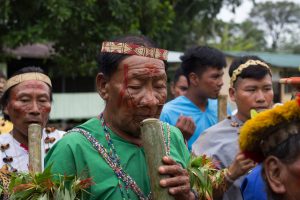
Just 1,600 Siekopai survive in a 50,000-acre fragment of rainforest, photo: Erin Deo
In response to the existential threats they face, Piaguaje and a group of other young Siekopai leaders have formed an organisation, Sëra, named after the spirit of heaven that arrives every summer to announce a new era. They have developed a number of innovative projects, safeguarding ancestral shamanic knowledge in video format and running environmental workshops with Siekopai youth.
“Ancestral knowledge is being rapidly lost,” he said. “Young people are no longer interested, due to the influence of the Western world. Our wise elders are dying without leaving a legacy.
“Together with another young Siekopai defender, I created a project to safeguard their knowledge with videos. We go out with them when they are harvesting plants and record them talking about how they identify and use them. This project brought our group of young leaders together.”
The group is now running school workshops to promote environmental awareness through intergenerational exchange between elders, parents and children.
“We talk about ancestral knowledge, the identification and uses of medicinal plants, the threats that we face. We ask, what is important to us, what do we want to preserve, as Siekopai? The aim is to instil in the children the consciousness that our territory matters, that they should have respect for the elders, for Mother Nature, for our own cosmovision [the worldviews shared by indigenous peoples].
“We know that the children are like seeds; if we plant in them the idea that they must cut down the jungle to plant oil palm, they will want to do that,” he said.
“But instead we are saying to them, ‘We must take care of the jungle, this is our wealth, there are other ways to do things, to survive’. That’s why I think education is so important.”
Piaguaje believes it can help combat climate change.
“The indigenous worldview is based on living in harmony with nature and other people, respecting everything around us,” he said.
“It is a model that does not require us to plunder all natural resources. We are taught that we are all part of Mother Nature, that it is our responsibility to use resources in a sustainable way.
“Mother Nature provides everything: medicine, food, water and air. We don’t need to destroy but to co-exist.
“This way of life is based on reciprocity. Even if the other person is different from me, we share. Sharing and co-operation. That is how our ancestors lived and that should be the model of how we live, too.
“I think a global shift towards these values could help to combat climate change.”
The People of Noon
José Gualinga is a leader of the Native People of Sarayaku, an indigenous Kichwa group with 1,400 inhabitants living in a remote part of Ecuador’s southern Amazon.
Known for their defence of the rights of nature and indigenous peoples, the Sarayaku call themselves the People of Noon, referring to an ancient prophecy of their ancestors claiming that they would be a pillar of resistance after other communities had surrendered – a beacon of light as strong as the midday sun.
In 2012, the Sarayaku won a historic victory at the Inter-American Court of Human Rights, which found that the Ecuadorian state had violated their rights by allowing an oil company to prospect in their territory without consultation.
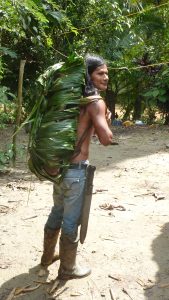
Photo: Beth Pitts
A turning point in the case came when José’s father, Don Sabino Gualinga, the spiritual leader of Sarayaku and their most eminent yachak (shaman), then aged 92, took the witness stand. He was asked about the impact of the 1,433kg of explosives that had been planted in Sarayaku territory by the oil company, accompanied by armed military personnel. Referring to the invisible beings that had been disturbed by the explosions, Don Sabino said that “half of the masters of the jungle are no longer there”.
He added: “It is a living forest. There are trees and medicinal plants and all kinds of beings … Many hid, others died when it burst. They are the ones who maintain the jungle, the forest … All of those who wish to cause damage, they don’t understand what they are doing. We do understand it, because we see it.”
The same year, the Sarayaku created the Kawsak Sacha (Living Forest) Declaration asserting that, as a living entity, their territory is subject to legal rights and demanding that these rights be upheld. The proposal was presented at global climate change conference COP21 in Paris and to French president François Hollande in 2015, and to the Ecuadorian government in 2018 before winning the prestigious UN Equator Prize in 2021.
The Sarayaku have also launched a professional football team to spread the word about oil exploitation in the Amazon; sailed a canoe down the Seine; and created a documentary, Children of the Jaguar, which won best documentary at the National Geographic Film Festival in 2012. Their 2021 documentary, The Return, which tells the story of one family’s retreat into the Amazon to escape Covid, was made for The Guardian and featured at the 2021 Sheffield DocFest.
In 2021, the Sarayaku are once again under threat, with the government’s plan to auction three million hectares of largely virgin rainforest to oil companies, including nearly all the Sarayaku territory. To represent their peaceful resistance to extractivism and commitment to defend the Kawsak Sacha, the Sarayaku are planting a 100km-long perimeter of flowering trees around their territory known as the Sisa Ñampi; it symbolises the fragility of life and the ephemeral limit of existence between life and death.
Gualinga believes that the philosophical thought of the Sarayaku can help combat climate change.
“Climate change will be resolved only if we actively seek solutions,” he said. “Global citizens must undertake a long road to resistance and peaceful struggle, towards a different perspective that we call tiam. By itself this philosophical thought is only a form of knowledge, but it can be made reality if each and every one of us participates in the minga [collective community work].
“Tiam is a counterpoint to the dominant worldview, which sees nature as ‘other’, as an object for exploitation. This has led to imbalance and severe climatic changes, as well as the current pandemic. At the heart of our philosophy lies the understanding that we live as an embryo in the womb of the Pachamama [Mother Earth]. Only in this way will nature be respected, will we live harmoniously, benefiting from the resources that the Pachamama bestows on us.
“We believe that if the human being accepts this way of life, the pain of the planetary wound will be felt, healed, and life will be born again.”
He added: “Indigenous peoples are already contributing towards global climate change solutions by taking care of their territories, which are mega-diversities of living beings. The Sarayaku conceived the Kawsak Sacha life project as a powerful nucleus, so that through these invisible beings, who are conscious and therefore have legal rights, we can regulate the balance of the earth and together we can fight climate change.”
Many communities of indigenous peoples have been divided by oil companies but the Sarayaku have maintained unity, said Gualinga.
“The unity of the Sarayaku arises from the legacy of our ancestors, from the great stories and prophecies that have led us to consider ourselves as the People of Noon, descendants of the jaguar, children of Amazanga Runa,” he said.
“Other nationalities – let us call them ‘communities’ or ‘peoples’ – their unity is maintained in a superficial way, through an organisation. While the statute of the organisation may be recognised by the competent authorities, the people lack the background of using their history and wisdom as a strength.
“When the unity of a society – or let’s call it a ‘cultural civilisation’ – of the Amazon forest is founded on historical and cultural principle, the oil companies cannot break it.”
The people of Sarayaku are masters in the selective use of modern technology, such as digital resource mapping, and using social networks without losing their cultural identity.
“If well used, technology can serve to strengthen new processes of collective and organised adaptation,” said Gualinga. “Based on this logic and analysis, the people of Sarayaku have adopted certain tools, such as the internet, which we use to disseminate the processes resistance in defence of our lives; to make known the proposals that come from within the territory and from the deep jungle. The jungle society has always been in a state of interaction, actively looking for solutions for threats such as climate change.
“Historically, it was impossible to make visible Sarayaku’s proposals in a dominant, complex world, full of wars and devastating economic conflicts. Now, with these new technologies, we can successfully disseminate communications on history, culture, proposals, visionary projects to conserve and protect the balance of the land and ensure the continuity of the Living Forest.
“These technologies have also allowed us to safeguard the memories of art, culture and stories, so that future generations can continue learning.”
Help the Siekopai Indigenous Amazonian Youth Foundation through its crowdfunding campaign at gofundme.com/f/siekopai-indigenous-amazonian-youth-foundation.
This article is based on interviews for Writers Rebel[/vc_column_text][/vc_column][/vc_row]
29 Sep 2021 | Afghanistan, Americas, Artistic Freedom Commentary and Reports, Asia and Pacific, Australia, Burma, Cuba, Ecuador, Europe and Central Asia, Israel, Lukashenko letters, Magazine, Magazine Contents, Middle East and North Africa, Religion and Culture, Russia, Syria, Turkey, Uganda, United Kingdom, United States, Volume 50.03 Autumn 2021, Volume 50.03 Autumn 2021 Extras
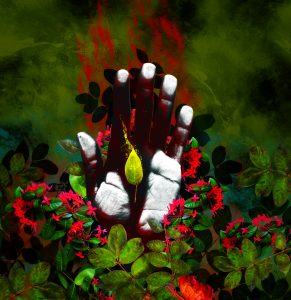
The Autumn issue of Index magazine focuses on the struggle for environmental justice by indigenous campaigners. Anticipating the United Nations Climate Change Conference (COP26), in Glasgow, in November, we’ve chosen to give voice to people who are constantly ignored in these discussions.
Writer Emily Brown talks to Yvonne Weldon, the first aboriginal mayoral candidate for Sydney, who is determined to fight for a green economy. Kaya Genç investigates the conspiracy theories and threats concerning green campaigners in Turkey, while Issa Sikiti da Silva reveals the openly hostile conditions that environmental activists have been through in Uganda.
Going to South America, Beth Pitts interviews two indigenous activists in Ecuador on declining populations and which methods they’ve been adopting to save their culture against the global giants extracting their resources.
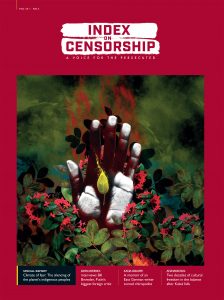 Cover of Index on Censorship Autumn 2021 (50-3)[/caption]
Cover of Index on Censorship Autumn 2021 (50-3)[/caption]
A climate of fear, by Martin Bright: Climate change is an era-defining issue. We must be able to speak out about it.
The Index: Free expression around the world today: the inspiring voices, the people who have been imprisoned and the trends, legislation and technology which are causing concern.
Pile-ons and censorship, by Maya Forstater: Maya Forstater was at the heart of an employment tribunal with significant ramifications. Read her response the Index’s last issue which discussed her case.
The West is frightened of confronting the bully, by John Sweeney: Meet Bill Browder. The political activist and financier most hated by Putin and the Kremlin.
An impossible choice, by Ruchi Kumar: The rapid advance of Taliban forces in Afghanistan has left little to no hope for journalists.
Words under fire, by Rachael Jolley: When oppressive regimes target free speech, libraries are usually top of their lists.
Letters from Lukashenka’s prisoners, by Maria Kalesnikava, Volha Takarchuk, Aliaksandr Vasilevich and Maxim Znak: Standing up to Europe’s last dictator lands you in jail. Read the heartbreaking testimony of the detained activists.
Bad blood, by Kelly Duda: How did an Arkansas blood scandal have reverberations around the world?
Welcome to hell, by Benjamin Lynch: Yangon’s Insein prison is where Myanmar’s dissidents are locked up. One photojournalist tells us of his time there.
Cartoon, by Ben Jennings: Are balanced debates really balanced? Ask Satan.[/vc_column_text][/vc_column][/vc_row][vc_row][vc_column][vc_custom_heading text=”Special Report” font_container=”tag:h2|font_size:22|text_align:left”][/vc_column][/vc_row][vc_row][vc_column][vc_column_text]
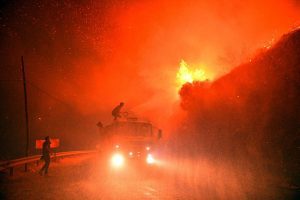
Credit: Xinhua/Alamy Live News
It’s not easy being green, by Kaya Genç: The Turkish government is fighting environmental protests with conspiracy theories.
It’s in our nature to fight, by Beth Pitts: The indigenous people of Ecuador are fighting for their future.
Respect for tradition, by Emily Brown: Australia has a history of “selective listening” when it comes to First Nations voices. But Aboriginal campaigners stand ready to share traditional knowledge.
The write way to fight, by Liz Jensen: Extinction Rebellion’s literary wing show that words remain our primary tool for protests.
Change in the pipeline? By Bridget Byrne: Indigenous American’s water is at risk. People are responding.
The rape of Uganda, by Issa Sikiti da Silva: Uganda’s natural resources continue to be plundered.Cigar smoke and mirrors, by James Bloodworth: Cuba’s propaganda must not blight our perception of it.
Denialism is not protected speech, by Oz Katerji: Should challenging facts be protected speech?
Permissible weapons, by Peter Hitchens: Peter Hitchens responds to Nerma Jelacic on her claims for disinformation in Syria.
No winners in Israel’s Ice Cream War, by Jo-Ann Mort: Is the boycott against Israel achieving anything?
Better out than in? By Mark Glanville: Can the ancient Euripides play The Bacchae explain hooliganism on the terraces?
Russia’s Greatest Export: Hostility to the free press, by Mikhail Khordokovsky: A billionaire exile tells us how Russia leads the way in the tactics employed to silence journalists.
Remembering Peter R de Vries, by Frederike Geeerdink: Read about the Dutch journalist gunned down for doing his job.
A right royal minefield, by John Lloyd: Whenever one of the Royal Family are interviewed, it seems to cause more problems.
A bulletin of frustration, by Ruth Smeeth: Climate change affects us all and we must fight for the voices being silenced by it.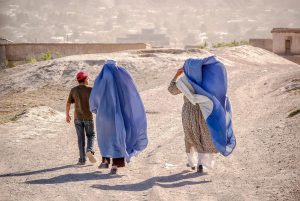 Credit: Gregory Maassen/Alamy[/caption]
Credit: Gregory Maassen/Alamy[/caption]
The man who blew up America, by David Grundy: Poet, playwright, activist and critic Amiri Baraka remains a controversial figure seven years after his death.
Suffering in silence, by Benjamin Lynch and Dr Parwana Fayyaz The award-winning poetry that reminds us of the values of free thought and how crucial it is for Afghan women.
Heart and Sole, by Mark Frary and Katja Oskamp: A fascinating extract gives us an insight into the bland lives of some of those who did not welcome the fall of the Berlin Wall.
Secret Agenda, by Martin Bright: Reforms to the UK’s Official Secret Act could create a chilling effect for journalists reporting on information in the public interest.






 Cover of Index on Censorship Autumn 2021 (50-3)[/caption]
Cover of Index on Censorship Autumn 2021 (50-3)[/caption]
 Credit: Gregory Maassen/Alamy[/caption]
Credit: Gregory Maassen/Alamy[/caption]